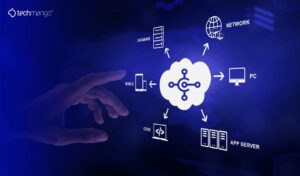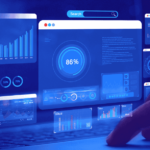Introduction: The Power of Data Visualization in Analytics
In today’s data-driven world, organizations have access to vast amounts of information. However, the challenge lies in making sense of this data and extracting meaningful insights that can drive decision-making and propel businesses forward. This is where data visualization comes into play. Data visualization is the process of representing complex data sets visually, using charts, graphs, and other visual elements to transform raw numbers into compelling stories.

The Benefits of Data Visualization in Presenting Complex Insights
Data visualization offers numerous benefits when it comes to presenting complex insights. Firstly, visualizing data makes it easier for individuals to understand and interpret information. By presenting data visually, analysts can convey intricate relationships and patterns in a more intuitive and accessible manner. This enhances comprehension and enables stakeholders to make informed decisions quickly.
Moreover, data visualization enhances data storytelling. It allows analysts to create narratives that captivate and engage their audience. By leveraging visual elements, analysts can highlight key findings, emphasize trends, and guide viewers through the data story. This not only improves comprehension but also increases the impact of the insights presented.
The Key Elements of Effective Data Visualization
To create effective data visualizations, there are several key elements to consider. Firstly, clarity is paramount. The visual representation should be clear and concise, ensuring that viewers can grasp the main message at a glance. Simplicity is also crucial, as overly complex visuals can confuse and overwhelm the audience. By focusing on the essential elements and removing unnecessary clutter, analysts can create visualizations that are both informative and visually appealing.
Another essential element is context. Providing context helps viewers understand the significance of the data and its implications. Annotations, labels, and captions can be used to provide additional information and guide viewers’ attention to important details. Additionally, interactivity can enhance engagement and exploration of the data. By allowing viewers to interact with the visualization, they can delve deeper into the insights and uncover hidden patterns or trends.
Releated blog
Conquer the Digital World with Stellar Data Transformation by Leveraging Techmango’s Bespoke Data Analytics Services
Data Visualization Tools: Empowering Analysts and Business Users Alike
With the increasing importance of data visualization, a wide range of tools and software solutions have emerged to assist analysts and business users in creating impactful visualizations. These tools provide a user-friendly interface and a variety of chart types, templates, and customization options. Some popular data visualization tools include Tableau, Power BI, and D3.js.
These tools enable analysts to transform raw data into visually stunning charts, graphs, maps, and dashboards. They offer functionalities for data manipulation, filtering, and aggregation, allowing users to explore and analyze data from multiple angles.
Furthermore, these tools often provide options for sharing and collaboration, making it easier to disseminate insights across teams and organizations.
Showcasing Real-World Examples of Stunning Data Visualizations
To illustrate the power of data visualization, let’s explore a few real-world examples of stunning visualizations. The New York Times’ interactive visualizations of the COVID-19 pandemic stand out as a prime example. Through interactive maps, line graphs, and bar charts, they effectively conveyed the spread of the virus, the impact on different regions, and the effectiveness of mitigation measures. These visualizations allowed readers to understand the complex data surrounding the pandemic and make informed decisions regarding their safety.
Another remarkable example is NASA’s Global Imagery Browse Services (GIBS), which provides satellite imagery of Earth in near-real-time. By visualizing data from various satellites, GIBS offers a captivating and informative view of our planet’s dynamic systems, including weather patterns, vegetation, and atmospheric conditions. These visualizations not only assist scientists in their research but also engage the general public in understanding and appreciating Earth’s beauty and fragility.
Releated Blog
Unleashing the Power of Data Analytics: How Businesses Can Harness Insights for Growth
Trends in Data Visualization: What to Expect in the Future?
As technology advances and data becomes more abundant, several trends are shaping the future of data visualization. One trend is the increasing integration of artificial intelligence (AI) and machine learning (ML) algorithms into data visualization tools. These algorithms can automatically analyze data and suggest the most appropriate visualization techniques, reducing the burden on analysts and enabling faster insights.
Another trend is the emergence of augmented reality (AR) and virtual reality (VR) in data visualization. AR and VR technologies provide immersive experiences, allowing users to interact with data in three-dimensional space. This has the potential to revolutionize data exploration and analysis, providing a more intuitive and immersive way to understand complex insights.
Incorporating Data Visualization into Your Analytics Strategy: Best Practices to Follow
To incorporate data visualization effectively into your analytics strategy, it is essential to follow a few best practices. Firstly, define clear objectives and identify the key insights you want to communicate. This will guide your visualization design and ensure that the visualizations are aligned with your analytical goals.
Next, know your audience. Consider their level of familiarity with data and choose visualizations that resonate with them. Tailor your visualizations to be easily understandable and visually appealing for your target audience.
Furthermore, choose the right visualization techniques for your data. Different types of data require different visual representations. Bar charts, line graphs, scatter plots, and heatmaps are just a few examples of the wide array of visualization options available. Select the most appropriate ones that effectively convey the insights you want to communicate.
Lastly, iterate and refine your visualizations. Seek feedback from stakeholders and users, and continuously improve your visualizations based on their input. Embrace a data-driven mindset, experimenting with different approaches and adjusting your visualizations based on the outcomes.
Conclusion: Harnessing the Power of Data Visualization for Impactful Analytics Insights
In conclusion, data visualization is a powerful tool that enables analysts and business users to transform complex insights into compelling stories. By harnessing the benefits of data visualization, organizations can enhance comprehension, engage stakeholders, and drive impactful decision-making. With the availability of advanced data visualization tools and the ongoing evolution of visualization trends, the future holds even more exciting possibilities.
Incorporating data visualization into your analytics strategy requires careful consideration of key elements, the selection of appropriate tools, and adherence to best practices. By embracing data visualization and continuously refining your visualizations, you can unlock the full potential of your data and unleash meaningful insights that drive success in your organization.







